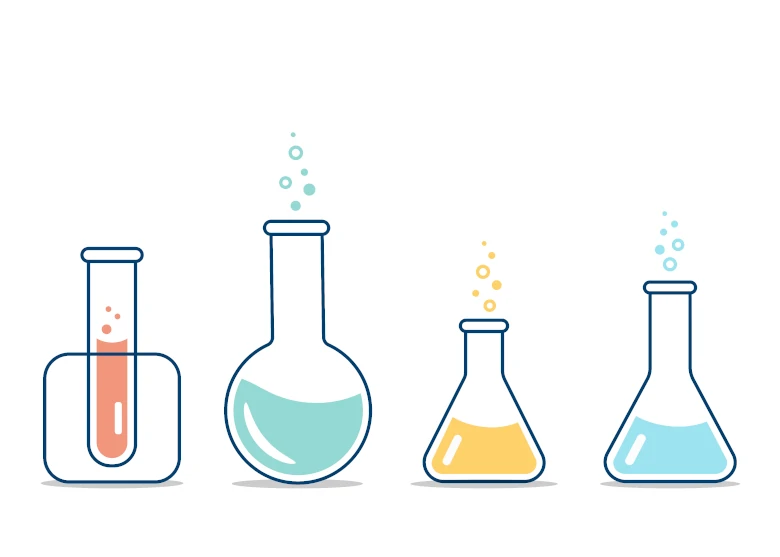Alkenes
In this article, we will cover the topic on Alkenes. These are the following learning outcomes:
- Describe alkenes as a homologous series of unsaturated hydrocarbons with the general formula CnH2n.
- Draw and name the first three alkenes.
- Describe the physical and chemical properties of alkenes.
Alkene Homologous Series
Alkenes are a homologous series of hydrocarbons that contain one or more carbon-carbon double covalent bonds (C = C).
Recall again that hydrocarbons are organic compounds that contain only hydrogen and carbon atoms.

The general formula of alkenes is CnH2n, where n = 2,3,4, etc.
From the general formula, it can be seen that the ratio of carbon to hydrogen in an alkene molecule is always 1:2. In other words, the number of hydrogen atoms will always be twice the number of carbon atoms.
Why can’t n take the value of 1 in the general formula?
All alkenes must have the same functional group of the C = C double bond. It means that the minimum number of carbon atoms in an alkene molecule must be 2.
Unsaturated Hydrocarbons
Any molecule that contains carbon-carbon C = C double bonds is unsaturated. Hence, alkenes are called unsaturated hydrocarbons.
A double bond is formed by sharing 2 pairs of electrons between the carbon atoms. In an alkene molecule, it does not have the maximum number of atoms for the number of carbon atoms present.
Here’s the dot-and-cross diagram of an ethene molecule.

Let’s get to know the alkenes!
When naming the alkenes, the prefix tells us the number of carbon atoms in the molecule and the suffix tells us the homologous series the molecule belongs to. The homologous series here is alkene, hence, the suffix is ‘-ene’.
The table below shows the names and molecular formula of the first three alkene molecules in the homologous series.
| Name | Number Of Carbon Atoms | Molecular Formula |
|---|---|---|
| ethene | 2 | C2H4 |
| propene | 3 | C3H6 |
| butene | 4 | C4H8 |
Observe the molecular formulae of the first three alkenes in the series. Each member of the alkene homologous series differs from the next by a - CH2 - unit.
Structural Formulae Of Alkenes
A structural formula shows how atoms are arranged in a molecule. It also shows the bonds between the atoms in a molecule.
The table below shows the structural formulae of the first three alkenes in the homologous series.
| Name | Molecular Formula | Structural Formula |
|---|---|---|
| ethene | C2H4 | |
| propene | C3H6 | |
| butene | C4H8 |
Note: The structural formula can also be displayed in a condensed manner. For instance, the condensed formula of ethene can be written as CH2CH2. The condensed formula of propene can be written as CH3CHCH2 while that of butene can be written as CH3CH2 CHCH2.
Test Your Skill
Question 1:
Which of the following statements correctly describes alkenes?
- Alkenes are a homologous series of saturated hydrocarbons that contain only carbon-carbon double covalent bonds.
- Alkenes are a homologous series of saturated hydrocarbons that contain only carbon-carbon single covalent bonds.
- Alkenes are unsaturated hydrocarbons that contain carbon-carbon double covalent bonds.
- Alkenes are unsaturated hydrocarbons that contain only carbon-carbon single covalent bonds.
Answer:
(C) Alkenes are unsaturated hydrocarbons that contain carbon-carbon double covalent bonds.
Explanation:
Alkanes are saturated hydrocarbons while alkenes are unsaturated hydrocarbons. Alkenes contain carbon-carbon double bonds.
Question 2:
Which of the following molecules belongs to the alkene homologous series?
- C25H50
- C30H64
- C50H80
- C35H60
Answer:
(A) C25H50
Explanation:
The general formula of alkenes is CnH2n. This means that the number of hydrogen atoms will always be twice the number of carbon atoms.
Physical Properties Of Alkenes
Similar to alkanes, as the number of carbon atoms increases,
- boiling points increase
- density increases
- viscosity increases
- flammability decreases
Characteristics Of Alkene Homologous Series
Alkenes are a homologous series containing unsaturated hydrocarbon with:
- same functional group (C = C)
- similar chemical properties
- same general formula (CnH2n)
- a gradual change in their physical properties.
- successive members differ by a –CH2– unit.
Question 3:
Which of the following correctly describes alkenes?
- Alkenes are saturated hydrocarbons.
- The boiling point of alkenes increases down the homologous series.
- The general formula of alkenes is CnH2n+2.
- The flammability of alkenes increases down the homologous series.
Answer:
(B) The boiling point of alkenes increases down the homologous series.
Explanation:
As the molecular sizes of the alkene molecules increase, the forces of attraction between the molecules also increase. More energy is needed to overcome these stronger forces of attraction.
Question 4:
The table shows the boiling points of three members of the alkene homologous series.
| Molecular Formula | Boiling Point / ºc |
|---|---|
| X | 36 |
| C4H8 | 6 |
| C3H6 | -48 |
Which of the following represents X?
- CH4
- C2H4
- C5H10
- C5H12
Answer:
(C) C5H10
Explanation:
The boiling point of an alkene increases as the number of carbon atoms in the molecule increases.
Between the three alkenes, C3H6 has the lowest boiling point, followed by C4H8, with X having the highest boiling point. Therefore, X must have a greater number of carbon atoms than C4H8.
Chemical Properties Of Alkenes
Alkenes undergo two main reactions – combustion and addition.
Combustion
Alkenes burn in excess air (oxygen), undergoing complete combustion, to produce carbon dioxide and water vapour.
Take the alkene, propene, for instance.
Word Equation:
propene + oxygen \(\xrightarrow{\quad}\) carbon dioxide + water vapour
Chemical Equation:
2C3H6 + 9O2 \(\xrightarrow{\quad}\) 6CO2 + 6H2O
Alkenes burn with a sootier flame than alkanes with a similar number of carbon atoms. This is because, for the same number of carbon atoms, the percentage of carbon by mass in alkene molecules is higher than that in alkane molecules.
Let us do a comparison of the percentage by mass of carbon in ethane and in ethene.
% of C in ethane, C2H6\(\begin{align}\\[2ex]
&= \frac{2 \times 12}{2 \times 12 + 6 \times 1} \times 100\% \\[2ex]
&= 80\%
\end{align}\)a
% of C in ethene, C2H4\(\begin{align}\\[2ex]
&= \frac{2 \times 12}{2 \times 12 + 4 \times 1} \times 100\% \\[2ex]
&= 85.7\%
\end{align}\)
Due to the greater percentage by mass of carbon in ethene, more oxygen is needed to react with the carbon atoms to form carbon dioxide for complete combustion.
Therefore, the chances of alkenes undergoing incomplete combustion will be higher, as there might be insufficient oxygen to react. Due to incomplete combustion, carbon (soot) or carbon monoxide will be produced, which makes the flame sootier.
Addition
An addition reaction is a reaction in which an unsaturated organic compound, such as alkene, can combine with another substance to form a single new compound.
The carbon-carbon double bond in an alkene breaks to form new single bonds. New atoms can be added to each carbon atom of the double bond to form a single covalent bond product.

In other words, after the addition reaction, the unsaturated alkene becomes a saturated product.
Examples of substances used in the addition reaction with alkenes:
- hydrogen
- bromine
- steam
Addition Of Hydrogen (Hydrogenation)
The addition of hydrogen is also known as hydrogenation. Alkenes can react with hydrogen to form alkanes.
For Example:
ethene + hydrogen \(\xrightarrow{\quad}\) ethane
C2H4 + H2 \(\xrightarrow{\quad}\) C2H6

Conditions Needed:
- Temperature: 200ºC
- Catalyst: Nickel
Application Of Hydrogenation
We can use the hydrogenation process in the manufacturing of margarine from vegetable oil.
Addition Of Bromine (Bromination)
If an alkene is added to a solution of bromine, the reddish-brown colour disappears (decolorises) immediately.
For Example:
ethene + bromine \(\xrightarrow{\quad}\) 1,2-dibromoethane
C2H4 + Br2 \(\xrightarrow{\quad}\) C2H4Br2
The final product in this bromination reaction is 1,2-dibromoethane. The numbers 1 and 2 in the name tell the positions of the bromine atoms on the main carbon chain.
The bromine solution is reddish-brown, but after bromination, the bromine is used up in the reaction, thus the reddish-brown colour disappears and a colorless liquid (1,2-dibromoethane) is formed.
The bromination reaction, thus allows us to distinguish saturated hydrocarbons (alkanes) from unsaturated hydrocarbons (alkenes). Alkanes do not undergo bromination under normal conditions, hence alkanes do not decolourise bromine solution.
Addition Of Steam (Hydration)
Alkenes can also undergo an addition reaction with steam, also known as hydration, to produce alcohols.
For Example:
ethene + steam \(\xrightarrow{\quad}\) ethanol
C2H4 + H2O \(\xrightarrow{\quad}\) C2H5OH
Conditions Needed:
- Temperature: 300ºC
- Pressure: 60 atm
- Catalyst: Phosphoric(V) acid, H3PO4
Question 5:
The structures of four organic compounds are shown below.

Which compounds decolourise bromine water?
- 1 and 2
- 1, 2 and 4
- 2 and 4
- 3 and 4
Answer:
(C) 2 and 4
Explanation:
The bromination reaction serves as a chemical test for the presence of unsaturated hydrocarbons. It is used to distinguish between an alkane and an alkene. Alkanes do not decolourise bromine solution under normal conditions, but alkenes decolourise bromine solution rapidly.
Compounds 2 and 4 are alkenes. Both of them have a C = C double bond each. The bromine atoms in the molecule will add to each carbon atom of the double bond.
| Continue Learning | |
|---|---|
| Metals | Introduction to Organic Chemistry |
| Alcohols | Speed of Reaction |
| Electrolysis | Energy Changes |
| Ammonia | Alkanes |
| Alkenes | Carboxylic Acids |
 SG
SG  VN
VN 











